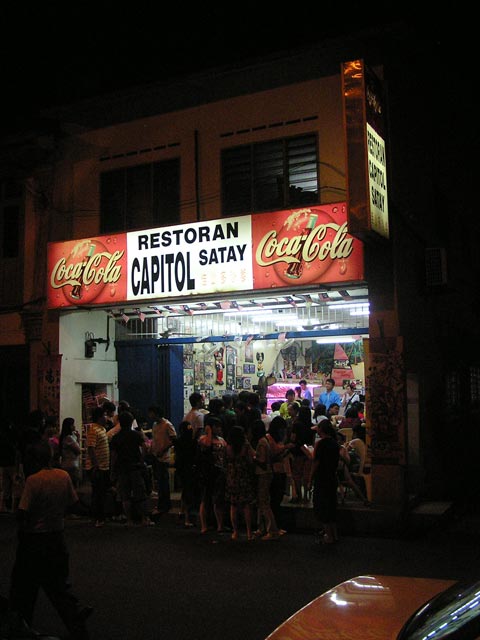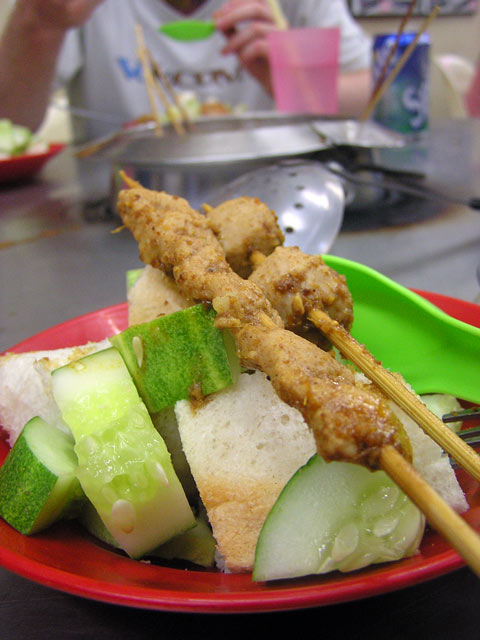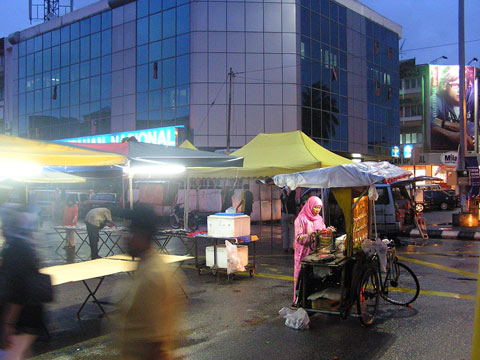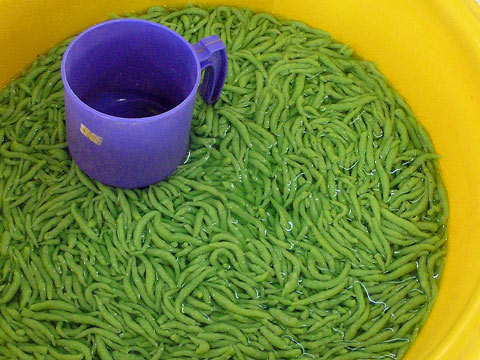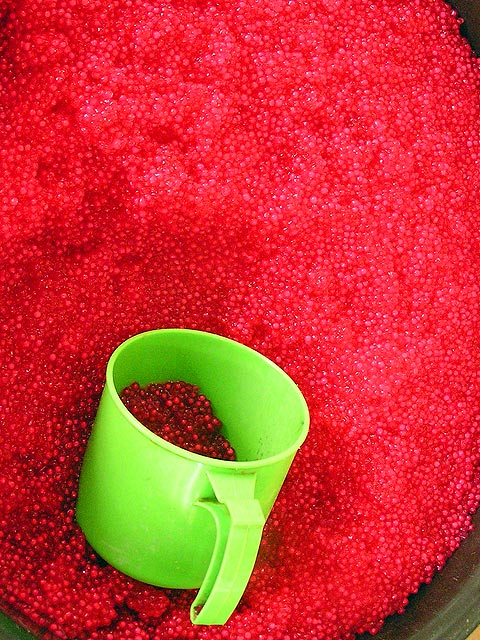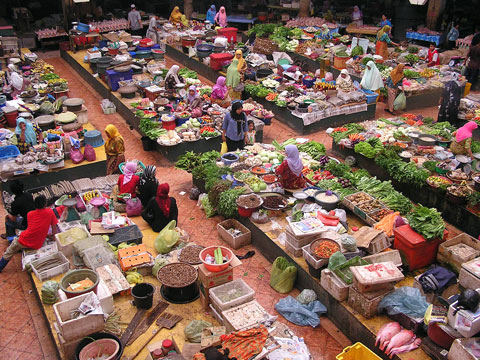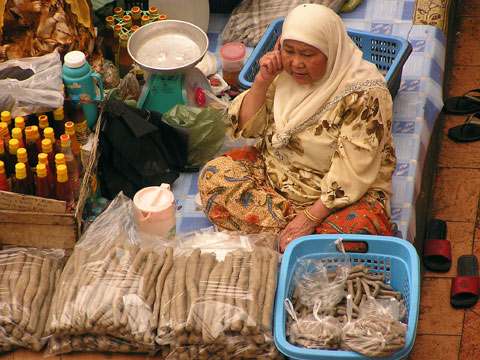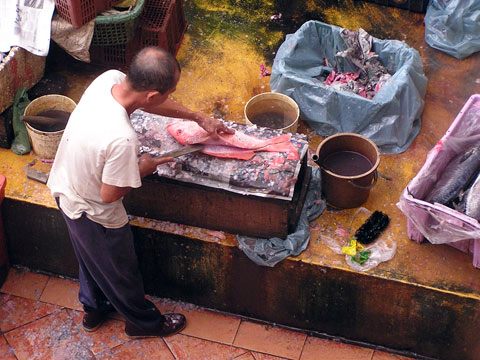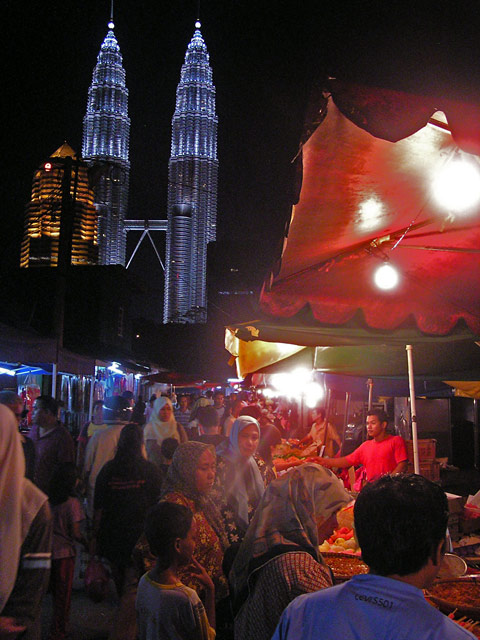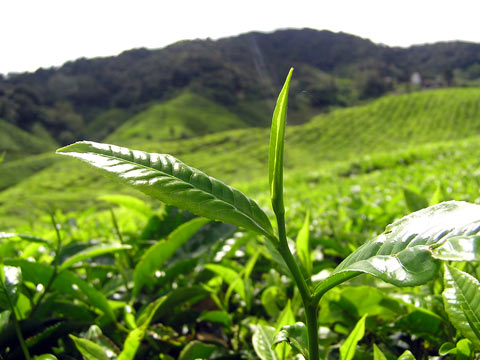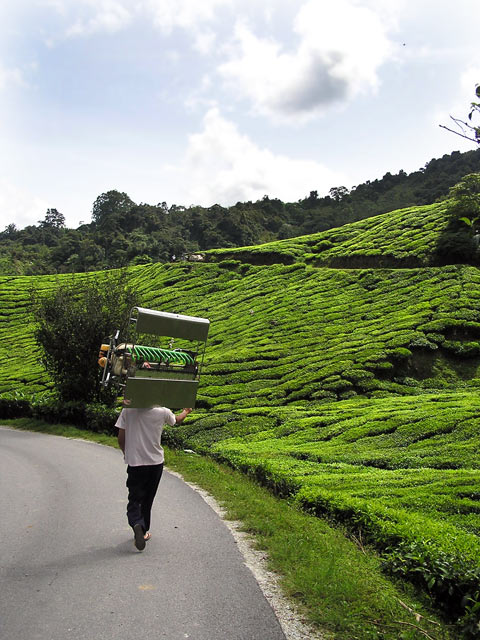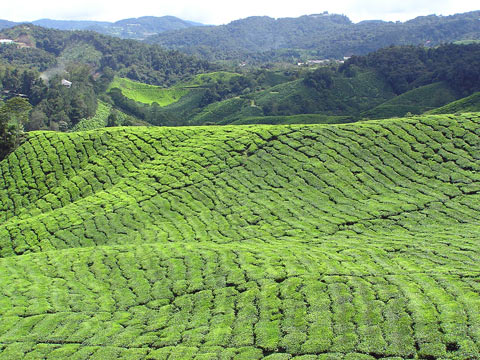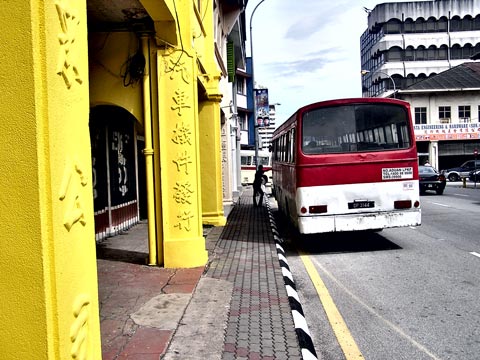
Midday street life in Ipoh, Malaysia. Heavily processed in photoshop
Satay and fondue, together at last
I never tire of regional novelties like cooking a skewer of something in a boiling pot of satay sauce, which constitutes something of a specialty in Melaka (Malacca), Malaysia and is the raison d’etre of Capitol Satay. This style of satay, satay celup, was (as far as I can find) invented by the owners of Capitol Satay in the 1950s and continues to be a reason for Kuala Lumpurites to drive down to Melaka to eat a morsel on a stick.
Capitol Satay on Lorong Bukit China is packed with satay-boiling punters from the moment it opens around 5:30pm until whatever ungodly hour that it closes. Pick from a random and wide array of skewered components from their refrigerator, ranging from meats to quail eggs to tofu and wontons, take a seat and wait for a roiling pot of peanut sauce to arrive at your table and present you with a new opportunity to burn yourself on a rich and sticky fluid.
The result: not as tasty as it is downright fun. The flavours of your chosen components barely make a dent in the satay sauce’s nuttiness, and conversely, very few of the components (apart from bread and tofu) soak up much sauce. I’m still positive that I lost a wonton in the sauce’s simmering brown depths never to be seen again.
Location:Capitol Satay Celup, 41, Lorong Bukit China, Melaka (Malacca), Malaysia
Kota Bharu Street Life
Cendol and pearls
These green worms are cendol (pronounced chen-dul), made from green pea flour flavoured with pandan leaves. They’re essential for making the dish that is their eponym: a combination of the worms, shaved ice, santan (the first extraction of coconut milk), gula (palm sugar) and often red beans. With a dish so simple, the only key is finding a vendor who uses top quality ingredients.
The same vendor selling the cendol had (what I’m guessing are) tapioca pearls, dyed red. From a distance I thought that they were pomegranate arils, but on closer inspection, they clearly were not.
Any suggestions?
See Also: The Star Online provides a recipe for cendol.
Kota Bharu’s Central Market

The central octagonal hall of Kota Bharu’s central market (Pasar Siti Khadijah) opens up like a cathedral devoted to the veneration of fresh Malaysian produce. A skylight illuminates the scene in a dull sepia glow throughout the day; upper levels providing a birds-eye view of the myriad proceedings below. By the crowded standard of Malaysia’s wet markets, Kota Bharu market has an overwhelming sense of austerity in comparison.
A while ago EatingAsia rhetorically asked whether you’d consider moving for a wet market, and for this one, I probably would. I ended up lingering for a few extra days in Kota Bharu just for the food, dropping by the market’s outstanding food hall for my curry fix. I had expected that Penang would be the sort of place that I could settle in, but not this northeastern corner of peninsular Malaysia. Maybe I could overlook the Kelantan state’s dominant but declining political party toying with the idea of hudud law. Maybe I could dismiss the concomitant lack of a brewery.
The ground floor plays host to primarily vegetable sellers on raised platforms with meats confined to the darker outer rim.
Keropok lekor, grey tubes of fish paste and starch, are probably one of the world’s least attractive foods in their pre-fried form. These snakes of sticky paste are sliced diagonally and then deep fried; giving a little crispness on the outer edges and chewiness to the centre. The flavour (in this case) is unrelenting fish.
I am always impressed by the effortlessness and economy by which people can clean a fish with a meat cleaver without destroying it. Any time I’ve tried it myself, I end up reverting back to a more flexible knife to peel out the chunks of fillet that I’ve missed entirely. The above method involved cutting the fish along the fillet on each side, then cleaving the head cleanly in two, so that the buyer received exactly half a fish, sans-innards.
See also:To Market, to market event at A Scientist in the Kitchen
I still ♥ wet season
Parking problems in downtown Kota Bharu, Malaysia. According to locals, this year the river was particularly high.
See also: I ♥ wet season, I ♥ hot season
Petronas Towers from Kampung Baru Night Market
As a casual photographer, there are not to be many moments when I rue the decision not to carry around a full-sized tripod, despite the highest ISO setting on my camera being 400. But this was one of those moments.
Kampung Baru’s (poorly lit) Sunday Market runs from around 6pm on Saturday night until the very early hours of Sunday morning, with street food in the foreground and those illuminated bamboo shoot-like Petronas Towers looming large behind. Kampung Baru itself is a fascinating slice of urban Kuala Lumpur at any time of day, as it is resolutely gripping onto the style of village life that tends to be erased in the mall-ification of Asian urban centers; which is why it was established in the first place. Listed in 1900 by the British as a Malay Agricultural Settlement, Kampung Baru was protected to attract rural Malays into Kuala Lumpur by mirroring the rural surrounds.
Location: Kampung Baru is behind the Kampung Baru LRT station.
See also: Masak Masak visits Kampung Baru’s Ramadan market; EatingAsia kicking it old school in Kampung Baru.
A sea of tea
I know very little about tea, apart from what you learn by osmosis from your Anglo-Australian grandparents. I can make a decent cup of black tea but tend to regard it as a sort of beverage bycatch; something that fits well alongside pho or yum cha or fruitcake. I have no idea how it is grown, processed or traded in large quantities. I was in Tanah Rata in Malaysia’s Cameron Highlands and this emboldened me to find out.
The general image of smiling, passive locals hand-picking tea that is planted by unscrupulous tea advertisers the world over is as wrong as it is Orientalist. Most of the tea in the Cameron Highlands is semi-mechanically harvested. Two people standing each side of the row of tea drag the above device across the new shoots, which slices and blows the fresh tea into a bag. Less accessible bushes on the mountain peaks and the depths of the ravines are still harvested by hand, but this represents an absolute minority of the total tea produced. In lowland plantations, a modified combine harvester drives over the top of the rows. The tea is allowed to resprout fresh tips that are then reharvested about every three weeks.
Once picked, the leaves are withered, crushed, torn and curled by machine then set aside to oxidise. The oxidation process is called “fermentation” for purely historical reasons as nothing ferments. The tea, now turned from green to black from oxidation, is dried, sorted, tasted and packed.

